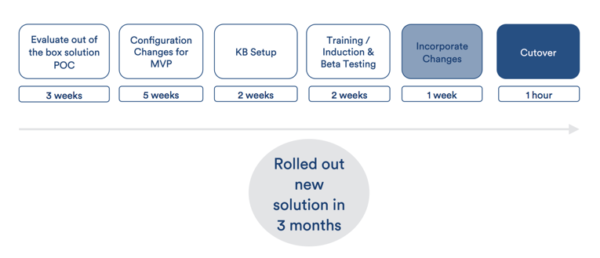 Flash back to April 2014: Carol Johnson, The Daily Telegraph’s Director of Service Delivery, was facing a seemingly impossible task.
Flash back to April 2014: Carol Johnson, The Daily Telegraph’s Director of Service Delivery, was facing a seemingly impossible task.
A few years prior, The Daily Telegraph outsourced all internal support operations to an external vendor. But the relationship with the vendor was failing. Service level agreements were met, but customer satisfaction with IT plummeted. The Daily Telegraph employees were unhappy because problems weren’t fully resolved.
It was crucial that Carol and her team provide great service to The Daily Telegraph’s 1,000+ employees. Over 3M readers get the news from The Daily Telegraph and the IT team is front and center in ensuring the paper and online properties publish without incident.
Carol and her team were tasked with a game-changing mission: bring service delivery back in-house and do it within three months.
Enter the agile manifesto
It wasn’t about tools. It was about going agile. So they decided to do something a little revolutionary: apply the same agile principles their software development teams use to their service delivery teams.
Carol turned to the agile manifesto’s principles and applied them during their set up of Jira Service Desk (which was a natural choice for tooling since their development teams already used Jira and Confluence). Going agile isn’t a just best practice; it’s a methodology that creates an atmosphere of lean ITSM and devops processes.
By going agile, The Daily Telegraph’s IT team met their three-month deadline, and ultimately succeeded in completing the mission. By the time you finish reading this, you will also have learned about their exceptional results in customer satisfaction.
How’d they do it? Let’s dive in.
#1: Individuals and interactions over processes and tools

Each day, Carol and her team conduct a face to face stand-up covering what they did, what they’ll be doing that day, and any blockers they have. By taking the five minutes to chat on a daily basis, the team could help each other immediately if there are any blockers.
Simply put, stand-ups work.
Daily stand-ups not only improve collaboration, but also strengthen team bonds. Team members are in the loop, engaged, and ready to tackle challenges together. In other words, problems get solved.
#2: Working software over comprehensive documentation
Instead of building out a “request for proposal” thousands of pages long, Carol and crew decided to work directly with customers to build a minimum viable product (MVP). There was no time to mess around on a project that turned out to be useless for everyone involved, so they listened to customers and responded quickly to their feedback and requests.
Their first MVP needed some pretty specific things:
- Customer portal
- Knowledge base articles for the top five most common issues (password reset, etc.)
- Queues
After setting it up, they introduced an MVP to The Daily Telegraph’s 1,000+ employees within three months.
#3: Customer collaboration over negotiation
 Because customer satisfaction was the highest priority, Carol and her team wanted every interaction to count. They wanted to make sure problems were solved – not just symptoms diagnosed. And for their part, customers didn’t want to wait on IT. They wanted to help themselves and get answers fast.
Because customer satisfaction was the highest priority, Carol and her team wanted every interaction to count. They wanted to make sure problems were solved – not just symptoms diagnosed. And for their part, customers didn’t want to wait on IT. They wanted to help themselves and get answers fast.
They established a killer self-service library, allowing customers to find the answers to some of the most common requests like the all-too-familiar password reset.
Since Carol and her team were racing against the clock, they had to make moves that mattered – delivering value on day one was everything. Investing in a knowledge base library that empowered their customers saved her team a lot of time.
#4: Responding to change over following a plan
 As with a lot of things worth doing, it didn’t go strictly according to plan. But that’s ok. Infused with the spirit of the agile manifesto, The Daily Telegraph’s IT team were open to changing requirements or customer requests. For example, they changed the language of service requests to make them more easily accessible to non-IT or technical employees at The Daily Telegraph. Their willingness to flex on simple issues like verbiage increased customer satisfaction all the more. And the proof, as they say, is in the pudding.
As with a lot of things worth doing, it didn’t go strictly according to plan. But that’s ok. Infused with the spirit of the agile manifesto, The Daily Telegraph’s IT team were open to changing requirements or customer requests. For example, they changed the language of service requests to make them more easily accessible to non-IT or technical employees at The Daily Telegraph. Their willingness to flex on simple issues like verbiage increased customer satisfaction all the more. And the proof, as they say, is in the pudding.
After setting up their new service desk, The Daily Telegraph’s service delivery team saw a 140% increase in customer satisfaction and a 66% reduction in resolution time.
Want to learn more or ask questions? Join us for our next webinar December 3rd at 11 AM PST, 11 AM Europe (CET), or 11 AM Australia (AEST). Carol will walk through how her team made the changes, what they learned, and what their vision for the future of The Daily Telegraph is.
P.S. Want to learn more about how The Daily Telegraph uses Jira Service Desk? Checkout this 2min video.

